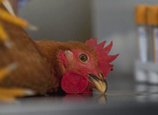
China's science and health authorities have announced a new project to fight the H7N9 virus, and plan to develop a vaccine within seven months.
The Ministry of Science and Technology and the National Health and Family Planning Commission announced on Wednesday the start of a joint research project to control H7N9, which includes diagnostic tests and vaccine development.
Several major science and technology projects had been carried out in China before the current H7N9 bird flu outbreak. This was good preparation for the new project, according to a Ministry of Science and Technology statement released to China Daily on Thursday.
Previous projects focused on detection technology for different types of the influenza A virus, completing the construction of a nationwide laboratory network for disease screening, and helping to develop a variety of therapeutic products.
Meanwhile, Chinese scientists have analyzed genetic fragments extracted from the H7N9 virus, and found it is probably the result of a gene reassortment of the bird flu virus carried by ducks, chicken and probably wild birds in the vicinity of Shanghai, Zhejiang province and Jiangsu province.
According to a news release by the Key Laboratory of Pathogenic Microbiology and Immunology at the Chinese Academy of Sciences, the genetic reassortment might have taken place in the Yangtze Delta area when wild birds migrated to that region.
A researcher at the laboratory said the DNA reassortment of H7N9 showed the H7 segment can be found on ducks in Zhejiang province, which could be traced to the flu virus carried by wild birds. The N9 segment is also homologous to the virus of the wild birds, which means the N9 segment corresponds in structure and character to the virus found in birds, the researcher said.
Earlier reports in China suggested the wild birds came from South Korea, but the laboratory denied this.
It said wild birds carrying the genetic segments might have taken a route to the Yangtze Delta area from Australia and East Asia, crossing a number of countries including South Korea.
The Chinese Academy of Sciences has launched a project to fight against the H7N9 virus, according to an announcement on its website. It will also look at preventing the virus from spreading and at new drugs to combat it.
Such projects played important roles in supporting the study of the causes or origins of disease, helping spread related research and drug development during the SARS pandemic in China in 2003, the bird flu outbreak in 2005 and the H1N1 outbreak in 2009.
In the new project, eight research institutions and one college under the academy will conduct joint research with the Chinese Center for Disease Control and Prevention, with the ultimate goal of providing scientific and technical support for preventing human H7N9 infection.

















 Homemade submarine, deep pockets | Also See: Incredible inventions by Chinese
Homemade submarine, deep pockets | Also See: Incredible inventions by Chinese


![]()
